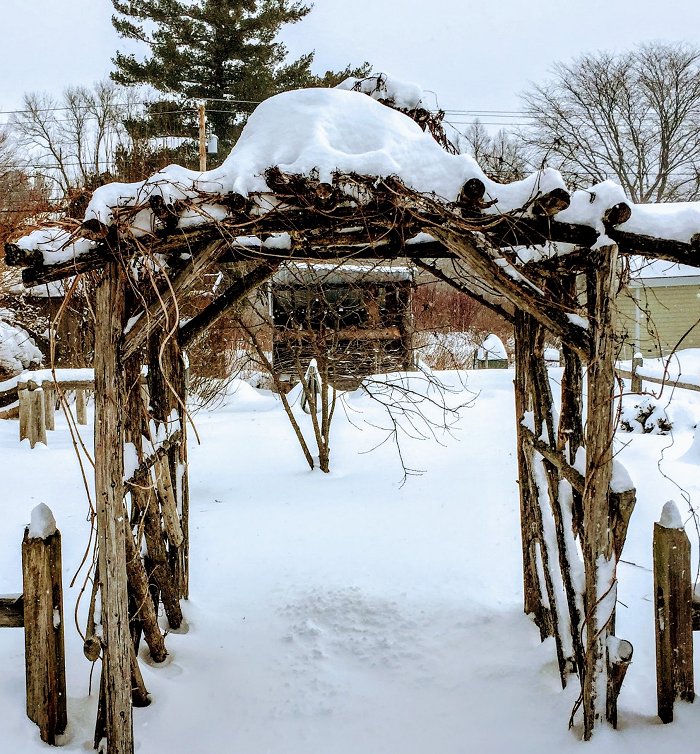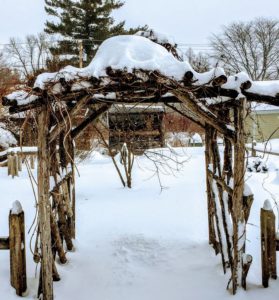Poor Man’s Fertilizer
Winter at Berkshire Botanical Garden: a time to collect poor man’s fertilizer for the coming season.
By Thomas Christopher
As I contemplate the task of plowing the driveway, I find it hard to see anything appealing in the previous night’s snowfall. Certainly, the idea of a white Christmas was a lot more appealing when I was contemplating pushing a toboggan rather than a snow blower. However, when faced with this chore, I try to console myself with the thought of all the benefits this stuff has for the garden.
“Poor man’s fertilizer” is what the old Yankees called snow, and there is considerable truth to that expression. Snowflakes absorb nitrates from the atmosphere as they as they form and fall and then release these nutrients into the soil as the snow melts. Much is lost with the water that runs off across the frozen ground in early thaws, but still, I’ve seen figures suggesting that as much as 5 to 10 lbs. of nitrates can be infiltrated into each acre of soil in this fashion during the average winter.
This effect is enhanced by air pollution. Nitrous oxide emissions from automobile and power plants wash down in rain and snow, considerably boosting the nitrate content of urban and suburban soils. This is a bad thing for the environment in many ways, especially as the nitrates wash into streams and then into lakes, rivers and coastal waterways. Those extra nitrates contribute to algal and plankton bloom that deplete the oxygen in the water, harming other aquatic plants and animals. But the extra nitrates can be a plus for the nutrient content of garden soils in those areas. Indeed, studies by forest ecologists have found that such extra nitrates can significantly accelerate the growth of trees, unless they occur at excessive levels – consistent heavy air pollution can over-saturate the soil, leading to leaching of nutrients and an actual stunting of plant growth. One study in particular found the rate of growth of eastern cottonwood saplings to be twice as fast in New York City as in surrounding rural areas.
In most of our region, snowfall is a net plus for plant growth. For it’s not just the snow’s nitrates that benefit garden plants. Snow shelters the plants beneath it from the dehydrating effects of winter winds. In addition, snow, especially dry, powdery snow, helps to insulate the ground underneath it, keeping the soil evenly cool and protecting it from sudden rises or plunges of air temperature. This in turn protects plants from the cycle of thaw and refreeze that they find particularly damaging. Repeated freezing and thawing of soil causes soil to expand and contract, which can damage your plants’ roots and heave shrubs and new plantings right out of the ground. In snow-less winters, it’s wise to mulch, but it takes a four to six inch layer of mulch to equal a good layer of snow in maintaining even soil temperatures and preventing heaving. In fact, it has been calculated that 10 inches of light snow can have an insulation value of R18, similar to a six inch layer of fiberglass insulation.
Gardeners have long understood the insulating quality of snow, at least intuitively. I remember when I was a student at the New York Botanical Garden that after each snowstorm, Karl Grieshaber, the German-born and trained curator of the rock garden, would march us students out to shovel the precious white stuff off the paths and onto his beds to protect his alpine plants against the vagaries of New York winter weather. The plants appreciated this treatment; I did not. But the memory helps me regard with more appreciation the often seemingly endless snows of a North Country winter.
Thomas Christopher is the co-author of “Garden Revolution” (Timber Press, 2016) and is a volunteer at Berkshire Botanical Garden. berkshirebotanical.org
Be-a-Better-Gardener is a community service of Berkshire Botanical Garden, one of the nation’s oldest botanical gardens in Stockbridge, MA. Its mission to provide knowledge of gardening and the environment through 25 display gardens and a diverse range of classes informs and inspires thousands of students and visitors on horticultural topics every year. Thomas Christopher is the co-author of Garden Revolution (Timber press, 2016) and is a volunteer at Berkshire Botanical Garden. berkshirebotanical.org.
Caption: Winter at Berkshire Botanical Garden: a time to collect poor man’s fertilizer for the coming season.




